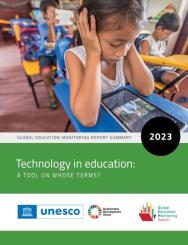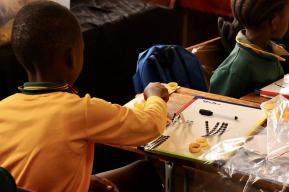Press release
Fast growth of digital technology is challenging education priorities and practices in South-East Asia


A new report by the Global Education Monitoring Report at UNESCO and the Southeast Asia Ministers of Education Organization (SEAMEO) launched on the sidelines of the 46th High Officials Meeting of SEAMEO shows that technology is changing the way education is being delivered in South-East Asia. It celebrates the increased ability of learners to access learning and connect in remote areas and during emergencies but cautions that technology is not a blanket solution for addressing major education challenges. Its potential for improving teaching and learning needs to be proven.
South-East Asia has placed high priority on technological reform for socioeconomic development. There are now some 400 million internet users in the region; in 2020, about 40 million went online for the first time. With almost 3 million enrolments, Indonesia, the Philippines and Viet Nam had the highest growth rate of new learners in Coursera, a massive open online course provider in 2021.

Entitled A tool on whose terms? The report launched at the high level event attended by ministries, partners, and stakeholders cautions that benefits for learners from these developments have been uneven, varying by community, socioeconomic level and teacher preparedness. Students from the richest households in the region are almost eight times more likely to be connected at home than the poorest students. Only half of rural primary schools are connected to the internet.
The report seeks to be our resource as we navigate the digital transformation in South-East Asia. It highlights the immense potential technology holds to revolutionize learning, foster innovative teaching methodologies, increase accessibility and inclusion, and improve education governance. However, it also sheds light on the challenges that demand our attention – issues of equity, access, governance and regulations, and the need for adaptable policies in the face of rapid technological advancements.
During her keynote message at the launch event, Her Excellency Sara Z Duterte, Vice President and Secretary of Education of the Republic of the Philippines and SEAMEO Council President, stated:
Technology in education is not merely about the tools and platforms; it is about how our learners engage, learn, and thrive. It must be relevant, evidence-based, scalable, and sustainable. Most especially, it should be on our learners’ terms, accommodating their diverse needs and contexts.
This is a critical inflection point for education policy makers in the region. Decisions on technology in school are often not based on evidence. Rigorous evaluation is often lacking, and evidence is not tailored to the South-East Asian context. Even companies cannot prove the effectiveness of their products: less than 10% of edtech companies operating in Indonesia could produce evidence of their products. Investments are being made without considering the long-term implications, with costs estimated at USD 18 billion to connect all schools in lower-middle-income countries in the region to the internet.
Discussions about education technology tend to focus on technology as a generic solution. They should focus on what are the education problems that need to be solved – and only then should it be asked whether technology can help tackle these problems. Nobody denies that digital literacy has become an essential part of a modern basic skill set. But while the need to teach about technology is clear, teaching through technology needs to prove its value - and evidence is thin.
A campaign #TechOnOurTerms alongside the report advocates for a learner-centered approach to digital education. Programmes ensuring that schools provide each student with a personal learning device were once used in the Philippines, Singapore and Thailand, for example. In Thailand, over 800,000 tablets were distributed to primary schools but this was then later discontinued due to implementation challenges.
Learners and teacher representatives also emphasized the need for equitable access to digital education tools and resources at the event. Ms Khan Anh Linh, student from Thammasat University shared,
As a student, I see the transformative potential of technology in education. However, it's crucial that these tools are thoughtfully designed to meet the diverse needs of students, ensuring that no one is left behind.
By embracing the recommendations of the GEM 2023 South-East Asia Report, we can collectively build an educational landscape that harnesses the power of technology for the benefit of all.
Three conditions are highlighted as necessary for the potential of technology in education to be fulfilled: equitable access to technology, appropriate governance and regulation, and sufficient teacher capacity.
Regulations must protect children’s wellbeing. In Cambodia, Indonesia, Malaysia and Thailand, 70% of surveyed adolescents reported upsetting online experiences. Meanwhile, about 30% of students in Viet Nam reported increasing distractions from social media and games while using technology to study. Brunei Darussalam, Malaysia and Viet Nam have restrictions on the use of smartphones in schools as a result.
Protection of children’s data is also needed, which technology applications in the region are collecting, including location. Yet, less than one in three countries protect data privacy in education by law or policy.
Better support is needed for teachers. In Cambodia, the Lao People’s Democratic Republic, Malaysia, Myanmar, the Philippines and Viet Nam, nearly one third of primary school teachers reported feeling ‘not very’ or ‘not at all’ confident in using ICT in 2019.
Media contacts:
UNESCO’s Global Education Monitoring Report:
Elsa Weill: el.weill(at)unesco.org- SEAMEO:
Pintip Iamnirath, pintip(at)seameo.org
About the Global Education Monitoring Report
Established in 2002, the GEM Report is an editorially independent report, hosted and published by UNESCO. At the 2015 World Education Forum, it received a mandate from 160 governments to monitor and report on progress on education in the Sustainable Development Goals (SDGs), with particular reference to the SDG 4 monitoring framework, and the implementation of national and international strategies to help hold all relevant partners to account for their commitments.
Visit the Global Education Monitoring Report's website.
About the Southeast Asian Ministers of Education Organization
Established in 1965, SEAMEO promotes regional cooperation in education, science and culture among 11 South-East Asian countries. SEAMEO counts on a network of 26 specialist centres and network that undertake training and research programmes in various fields of education, science, and culture. SEAMEO’s vision is to nurture human capacities and explore its peoples’ fullest potential, making their lives better through quality and equity in education, and information and communication technology, among others, in South-East Asia.
See also:
- The global edition and its summary of the report (below)
- UNESCO Regional Office in Bangkok
- UNESCO Regional Office in Jakarta
- UNESCO Office in Phnom Penh
- UNESCO Office in Hanoi
#EDCoordinationAsiaPacific #ICTinEducation #DigitalTechnologies











